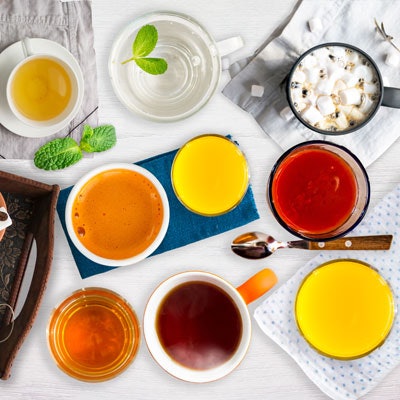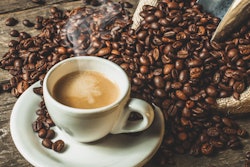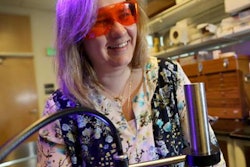
The demand for aesthetic restorative materials has increased as has the consumption of acidic beverages. But how do these drinks affect these new materials? To find out, researchers examined the effects of beverages, including coffee and an energy drink, on a resin composite, a compomer, and a giomer.
In the laboratory, they quantified how orange juice, cola, coffee, and an energy drink influenced the wettability, surface hardness, and color stability of these aesthetic restorative materials, finding that the changes varied by material and drink. Their study was published in the Dental Materials Journal (October 5, 2018).
"The extent of change in the restorative materials increased with duration and frequency of contact with the beverages, so a reduction in the frequency of ingestion of these beverages is recommended," wrote the authors, led by Ji-Won Choi of the dental hygiene department at Konyang University College of Medical Science in Daejeon, South Korea.
To drink or not to drink
Previous research illustrates that frequently drinking beverages with a low pH corrodes teeth, but more short-term research is needed on the effects of these beverages on various aesthetic restorative materials, according to the current study authors.
To directly observe such changes, the authors compared the effects over time of exposure to cola, orange juice, coffee, an energy drink, or the control of mineral water on the wettability, surface hardness, and color of three commonly used aesthetic materials. These materials were a resin composite (Filtek Z250, 3M), compomer (Dyract XP, Dentsply Sirona), and giomer (Beautifil II, Shofu), all in a color corresponding to the tooth shade of A3. A giomer is a hybrid of a glass ionomer and composite material.
The researchers fabricated 75 disk-shaped acrylic molds 6 mm in diameter and 2-mm high made from each of the restorative materials. They produced even surfaces for each of the samples using a polisher (CC261 #2000, Deerfos).
During the experiment, the researchers stored the samples at 37° C in distilled water. They submerged them in the beverages for three hours daily for five days, replacing the beverages each day. The investigators measured wettability, surface hardness, and color stability of each sample before submersion and after one and five days of submersion.
They measured the pH of each beverage three times after leaving it at room temperature for six hours before opening. The carbonated beverages (cola and energy drink) underwent stirring with a magnetic stirrer during that time. The investigators recorded the pH values of the beverages as follows: cola (1.40), orange juice (3.01), coffee (4.45), energy drink (2.18), and water (7.00).
They measured wettability of the restorative materials by contact angle measurement using a contact angle analyzer and contact angle measurement software. They measured the surface hardness of the restorative materials using a Vickers Hardness tester and the color of the beverages and the change in color of the restorative materials after submersion using a spectrophotometer.
Submersion in all the beverages, including water, significantly reduced the contact angles for all of the restorative materials. The resin composite was the most affected by the energy drink, the compomer by the cola, and the giomer by coffee. Overall, the resin composite had the lowest contact angle reduction rate, while the giomer had the highest (see table below).
| Comparison of the change in contact angle among beverages after 5 days of submersion | |||
| Restorative material | |||
| Beverage | Compomer | Giomer | Resin composite |
| Water (control) | 16.53 | 12.04 | 5.10 |
| Orange juice | 46.77 | 44.53 | 31.65 |
| Coffee | 49.53 | 59.02 | 36.13 |
| Cola | 55.49 | 48.71 | 22.68 |
| Energy drink | 52.73 | 50.30 | 49.00 |
Microhardness significantly changed for all the restorative materials. Submersion in the energy drink caused the highest reduction for the resin composite and compomer, while it was the cola for the giomer. Overall, the resin composite had the lowest reduction rate, and the compomer the had the highest (see table below).
| Comparison of Vickers microhardness reduction rates | |||
| Restorative material | |||
| Beverage | Compomer | Giomer | Resin composite |
| Water (control) | 12.93 | 6.40 | 6.68 |
| Orange juice | 24.28 | 13.40 | 15.90 |
| Coffee | 17.90 | 13.73 | 11.60 |
| Cola | 19.23 | 20.63 | 17.60 |
| Energy drink | 24.60 | 20.45 | 18.33 |
The greatest color changes for all three materials occurred with submersion in coffee. For the resin composite and giomer after the fifth day, the color changes between the water control and the other drinks were significant, while for the compomer, they were significant except for the orange juice. Overall, the resin composite had the smallest reduction rate and giomer had the highest.
"As the amount of beverage consumed and contact time with the aesthetic restorative material increased, its wettability increased significantly (p < 0.05), surface hardness decreased significantly (p < 0.05), and although there were color changes, they were not significant for all beverages," the authors wrote.
They added that exposure to the energy drink and cola led to the greatest deterioration in wettability and microhardness.
Analysis not complete
The researchers noted they were not able to analyze all components of the beverages or restorative materials and could not consider physiochemical reactions. They recommended that future experiments examine physiochemical reactions between specific components of the beverages.
For now, their results indicated that the resin composite experienced the smallest changes compared with the other materials, the authors wrote.
"This is likely due to its superior physical properties, and it is recommended that physical properties be considered when selecting aesthetic restorative materials," they concluded.



















